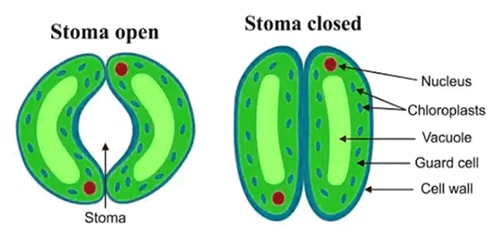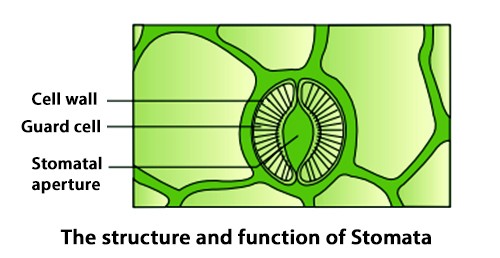Stomata: Some minute pores which are usually, found in leaf for the exchange of gas and transpiration are known as stomata (singular stoma).
Stomata are found on the leaves of plants. They can either be present on either the sides or just on one side of the leaf. They are essential for a plant’s life functions because they allocate carbon-containing carbon dioxide gas to enter the plant’s tissues. The stomata might occur on any part of a plant except the roots.
Stomata open and close to allow the intake of carbon dioxide and the discharge of oxygen. It’s very vital that they do this because this is the very oxygen that we ourselves need to respire!
Position:
i) Stomata are present in the green pan of leaf stem, green sepals and a green outer layer of the flower.
ii) Stomata are present on the lower epidermis of dorsiventral leaves, upper and lower epidermis of isolateral leaves and partly on the floating leaves of aquatic plants.

Structure
- Stomata are present in leaf epidermis.
- The stomatal pores are very minute and are covered with crescent-shaped guard cells.
- The outer wall of guard cells are thin and the inner wall is thick. Each guard cell contains cytoplasm, a nucleus and plenty of chloroplasts.
- There is a single large air chamber below the stomatal pore.
- They control the procedure of transpiration and gaseous exchange.
- They are enclosed by two bean-shaped guard cells
- The guard cells organize the opening and closing of stomata. The opening and closing of stomata are brought about by changes in the volume and form of the guard cells.
- The wall of the guard cell surrounding the pore is thickened and inelastic due to the rest of the walls is thin, elastic and semi-permeable.
- The expansion and contraction of the guard cells are caused due to the accomplishment of turgid and flaccid situation correspondingly.
Functions of stomata: The two main functions of stomata are to allow for the uptake of carbon dioxide and to limit the loss of water due to evaporation.
- The gaseous exchange (CO2 and O2) between the intercellular spaces of plant cell and the outer air takes place through stomata during photosynthesis
- During respiration, plants receive O2 and release CO2 through stomata.
- Stomata allow the ingress of carbon dioxide and release of oxygen i.e. gaseous exchange takes place through stomata. These gas molecules are really the source of the carbon atoms used by plants to create sugars, proteins, and other vital materials for life.
- Stomata help in loss of excess water from the surface of leaves in the form of water vapor in plants. The phenomenon is known as transpiration.
- In plants, carbon dioxide and oxygen are exchanged through the stomata by diffusion. Diffusion is the movement of a substance from a region of higher concentration to a region of lower concentration.
Photosynthesis
The gas exchange that occurs when stomata are open facilitates photosynthesis. Photosynthesis is the procedure by which plants change sunlight into utilizable energy. During photosynthesis, carbon dioxide is taken in from the environment through the stomata and oxygen is released as a waste product. Both photosynthesis and the gas exchange that powers it is vital to the plant’s survival.
Transpiration
Transpiration is a procedure of evaporation of water from the surface of the plant. This is done through the stomata openings. This helps the plant to get cool and also helps in the convey of minerals and other materials to different parts of the plant.













